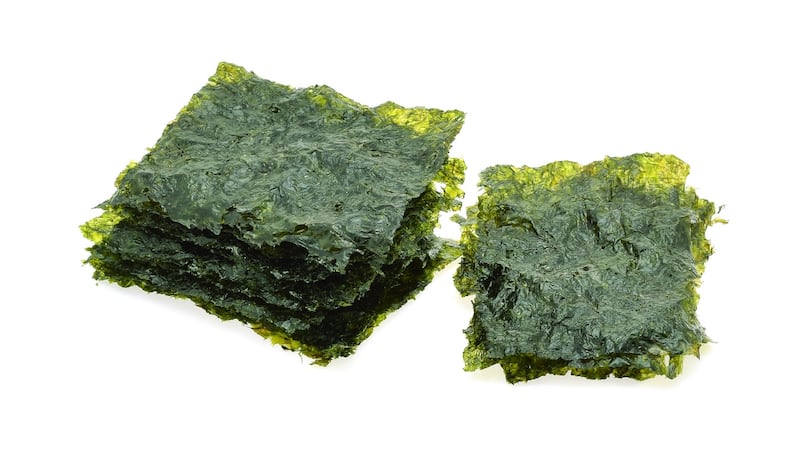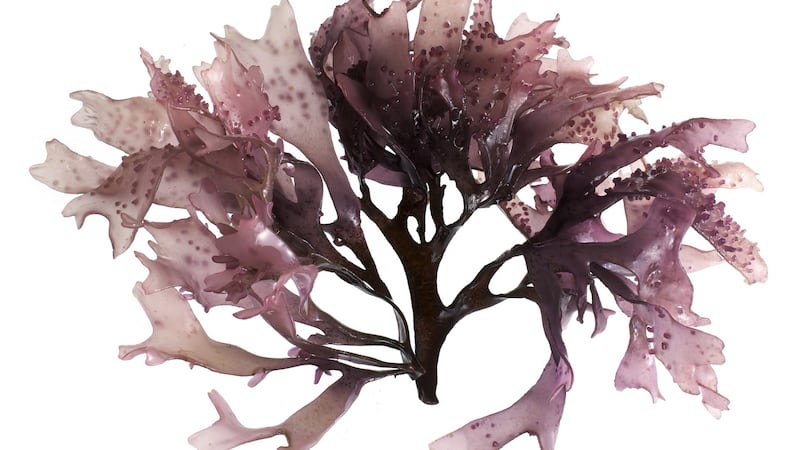
Our world is one of bountiful offerings. In summertime, the land offers up its cornucopia of fruit, nuts, cereals and vegetables – both wild and cultivated. Then, in winter, everything gets reversed. The sun retreats and the ocean flows forth to provide its own alternative bounty in the form of seaweeds and sea vegetables that grow best as the water grows colder and there is less bleaching by the sun’s rays.
This balance was long recognised by our ancestors and is reflected in the Irish language names of seaweeds, such as that for Ireland's most common and useful kelp, Laminaria hyperborea, which is "feamainn gheimhridh" – winter seaweed. Once the winter storms strike, this seaweed tumbles ashore in abundant jumbles of brownish-reddy clumps with sea rods attached. It was regarded as an offering from the ocean to be spread upon the dormant land to nourish the soil for the season ahead.
On bleak December mornings when a swell was spotted, men, women and children would rush to the shore to collect up the feamainn gheimhridh before the undertow of the ebbing tide covered it with sand and ruined it. It was no easy task, involving wading out to their necks in the freezing waters to haul in this bounty and then long hours spent cutting the rods off each piece of seaweed so that they could be burnt separately for the making of kelp powder. All this toil and risk was worthwhile only because the seaweed was so valuable.
Winter seaweed traditions are still alive in many parts of Ireland: on Tory Island, dúlamán (channelled wrack) is considered at its best at Christmas when the tips are cut to about thumb-length and then boiled to make "the healthiest food imaginable", as one old man told the folklorist Seán Ó hEochaidh in the 1950s. An ancient poem claims that the dúlamán from Carraig Chormadáin near Glencolmcille was one of the two foods that St Colmcille survived on – the other being green clover.
Secret spot
On Loop Head, Co Clare, families still have their own secret spot for gathering sleabhac (nori, laver, sloke), which was believed to be at its finest and freshest after the first frosts have bitten in midwinter. While fresh nutritional vegetables can be in short supply at this time of year, sleabhac more than compensates with its brimming bounty of vitamins A, B, C, D, E and K, copper, iron, magnesium, manganese, phosphorus, potassium, selenium, zinc and calcium. In fact, sleabhac can have up to 10 times more calcium than milk, alongside niacin, folic acid, taurine and polyphenols like carotenoids and flavonoids. It also contains several types of alkaloids with antioxidant properties and chlorophyll, which is a natural detoxifier. It is at its nutritional finest, though, from the middle of spring to early summer.

Maybe, it is no surprise that the word sleabhac also refers to the resilient mix of tough dermal bone and keratinised cells that form the inside of an animal horn, the part that gives a horn its strength. Certainly, the notion of associating the attribute of solidity with sleabhac doesn’t come from its appearance, which even at its best, in full winter prime, looks like decomposing vegetable sludge. Its ragged, thin, clingfilm-like membranes are only one or two cells thick and can vary in colour between purple, pink, grey and black. They look their finest underwater, but even then are still most like wan, slender stretches of frayed silk that drape themselves languorously over rocks when the tide goes out.
It is this latter characteristic that gives sleabhac its second meaning: to droop, slouch, fade, flag or become limp. “Tá an bláth ag sleabhcadh” means “the flower is wilting”, and “ag sleabhcadh leis an ocras” means “limp from hunger”.
Look for the droopiest plant on the shore and you’ll have found sleabhac. If it happens to be a rich supply make a note of where it is, as you now have access to a vitamin and nutritional larder that will power you through many winters to come.
Otherworldly being
Such was the mysterious potency of seaweeds that the word sleabhac can also refer to a dark otherworldly being. The phrase “go dtuga an sleabhac leis é” means “may the devil take him”, with the word sleabhac standing in for the devil. A demon is also replaced by the word seaweed in the phrase “bíodh an fheamainn aige”, which means “let him go to the devil”, or “he can go to blazes”, but literally translates as “let him have the seaweed”.
It may seem odd that one of the most nutritious and life-giving plants can be turned into a curse, but if I was to put mo mhaide san fheamainn (offer my tuppence-worth, or literally put my oar into the seaweed), I’d say that it arises from the very fact that it was so highly esteemed. The fractiousness of disagreements that broke out over seaweed rights among coastal families is legendary, with every clan zealously guarding their own carefully delineated supply. Just as with turf-cutting in more recent times, there were constant tensions between neighbours over possible encroachments upon their patches, and so it is possible that seaweed that had been taken became a curse word to fling at the accused. This interpretation is borne out by the proverb: “Tá mise ceart, bíodh an fheamainn ag an bhfear eile” (“I’m okay, let the guy have the seaweed.”) The antagonism over turf-gathering in summer saw its equal and opposite with the practice of seaweed-gathering in winter.

Duileasc, or dulse, is another seaweed that thrives particularly well in winter when the land is dormant. It is in the stormy winter months that its flavour matures. Tory Islanders referred to three different types of the seaweed: duileasc ropáin, duileasc buan and duileasc creathnach. The first was best picked before St Patrick’s Day, and the second preferably picked in May. All three were sweeter and stronger when growing on the exposed north side of the island, as a rougher current made for better flavour.
In west Kerry, dulse was known as míobhán, which elsewhere means a stimulating sea breeze or a form of intoxication, both of which are apt metaphors for the jolt you get from a mouthful of delicious mineral-rich duileasc. A woman in the poor house in Killarney in 1938, Bean Uí Bhuirtínig, recalls collecting míobhán in her youth after spring tides in Caherciveen and drying it on the shore flags; some of it was fed to children as a nutritional booster while the rest was sold for 5 shillings per half bag.
Honouring traditions
Since winter is a time for turning inwards and honouring the traditions of our forefathers, it is fitting that we focus now on the legacy of our ancient seaweed practices. For the many of us who have been inspired by Prannie Rhatigan’s revelatory book Irish Seaweed Kitchen (the first-ever modern book about seaweed cooking in the English language), it is appropriate that she has just published a new book aimed at blending modern winter customs and traditions with our age-old seaweed culture (Irish Seaweed Christmas Kitchen by Prannie Rhatigan, €18.50, www.irishseaweedkitchen.ie).
With newly concocted recipes such as for nori truffles, she is attempting to combine our ancient shore-foraging practices with our more recent midwinter customs. She offers guidance on how to make such unusual concoctions as homemade vanilla extract with sea spaghetti and a brandied sugar kelp collar for fruitcake, which can seem odd at first. However, if we are to revive our seaweed-gathering practices we need to be inspired to use seaweed in new and novel ways.
And while we are it we should also try to bring back some of the potent and evocative seaweed words that risk being lost from the Irish language: words likes bacán, which is a hook for gathering seaweed on the Aran Islands, or cál leannógach, the mushy green clumps of old sea plants that get washed up on the tide, or best of all, roc, which refers to wrinkles in general, but also specifically to the gentle puckering on the ocean surface caused by seaweed tips brushing it from below. Hopefully Rhatigan’s book will stimulate the minds and bellies of people this winter, encouraging them to head out to sample the riches of the shoreline.






















